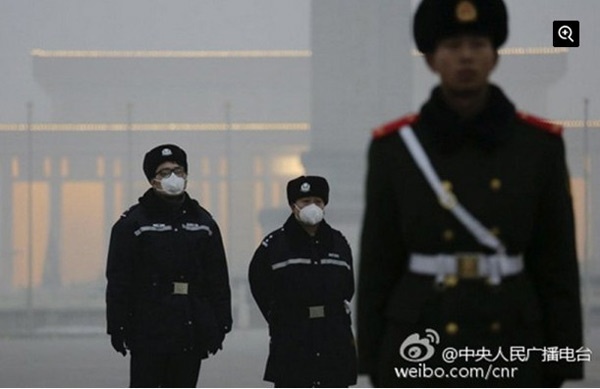

 |
| Police officers in Beijing put on masks for the first time while they carry out patrol duty around downtown Beijing's Tiananmen Square amid Beijing's thick smog on December 9, 2015. After Beijing's municipal government issued on Tuesday its first "Red Alert" for air pollution in 2015, local authorities have suspended school classes and construction sites, and also implemented odd-even plate number restrictions on vehicles. [Photo: weibo.com] |
According to the Ministry of Environmental Protection, since Dec. 5, due to the large quantity of pollutants discharged and the unfavorable climate conditions, Beijing and its neighboring regions have seen severe smog.
To better understand the cause, developing trend of the heavy pollution and the effect of the red alert measures in Beijing, a research team constituted by experts from Chinese Academy of Sciences, Tsinghua University, Peking University, China National Environmental Monitoring Center and other top research institutions has conducted a study on the smog this week.
Experts believe that the heavy air pollution this week is the result of the joint action of unfavorable climate condition and multiple sources of pollution.
Analysis on monitoring data shows that the sources of the pollutants of this week's smog are, in order of quantity, coal combustion, vehicle emission, industrial sources, fugitive dust and other sources. Pollutants from coal combustion mainly came from scattered burning of raw coal and emissions from small and medium-sized boilers. The vehicle emission includes gasoline car emission and diesel engine emission. The industrial sources include the steel manufacturing, petrochemical engineering, building material production and other industrial productions in the region. In terms of the city of Beijing, the main sources of pollutants are scattered burning of raw coal and vehicle emission.
"Data show that after Beijing implemented the air pollution red alert measures, the emission reduction averaged about 30 percent. If we didn't take such measures, the PM2.5 density would be 10 percent higher," said Cheng Shuiyuan, professor of Environment and Energy Engineering School of Beijing University of Technology. Monitoring data show that the emergency measures have obvious effect on preventing the smog from going worse.
 Chinese beauty with sexiest bottom
Chinese beauty with sexiest bottom All-star Carnival held in Beijing
All-star Carnival held in Beijing Charming female bodybuilders of Chengdu University
Charming female bodybuilders of Chengdu University Polish sports stars strip off for risqué calendar
Polish sports stars strip off for risqué calendar Spectacular aerial photos of the Three Gorges
Spectacular aerial photos of the Three Gorges Contestants of Mrs. Globe pose for photo in Shenzhen
Contestants of Mrs. Globe pose for photo in Shenzhen
 Bikini models attend hot pot banquet in Hefei
Bikini models attend hot pot banquet in Hefei J-10B fighters with homegrown engine in test fligh
J-10B fighters with homegrown engine in test fligh Photos of U.S. Navy intruding in South China Sea released
Photos of U.S. Navy intruding in South China Sea released Top 20 hottest women in the world in 2014
Top 20 hottest women in the world in 2014 Top 10 hardest languages to learn
Top 10 hardest languages to learn 10 Chinese female stars with most beautiful faces
10 Chinese female stars with most beautiful faces China’s Top 10 Unique Bridges, Highways and Roads
China’s Top 10 Unique Bridges, Highways and RoadsDay|Week